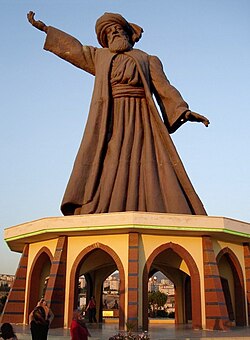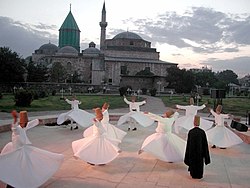鲁米
外观
魯米 | |
|---|---|
 | |
| 頭銜 | 我們的導師(مولانا) 吾師(مولوی) |
| 个人资料 | |
| 出生 | 1207年9月30日🇮🇷 |
| 逝世 | 1273年12月17日(66歲)🇮🇷 |
| 墓地 | |
| 宗教信仰 | 伊斯蘭教 |
| 民族 | 波斯人 |
| 年代 | 伊斯蘭黃金時代 |
| 地区 | 花剌子模王國 |
| 宗派 | 遜尼派[6] |
| 法理 | 哈納菲法學派 |
| 专业领域 | 蘇菲詩、哈納菲教法學 |
| 著名思想 | 蘇菲旋舞、穆拉卡巴 |
| 著作 | 《瑪斯納維》 《沙姆斯詩集》 《其中之中》🇮🇷 |
| 塔里卡 | 梅夫拉維教團 |
| 高級職位 | |

梅夫拉那·贾拉尔-阿德-丁·穆罕默德·鲁米(波斯语:مولانا جلال الدین محمد رومی,土耳其语:Mevlânâ Celâleddin Mehmed Rumi,1207年9月30日—1273年12月17日),常简称鲁米,伊斯兰教苏菲派神秘主义诗人、教法学家,生活于13世纪塞尔柱帝国统治下的波斯
生平
鲁米出生于呼罗珊境内的巴尔赫,逝世于今日土耳其境内的科尼亞。他一生主要以波斯语写作,也有少量以阿拉伯语、希腊语写出的作品。他的作品影响广泛,其中最为重要的是其诗集《玛斯纳维》突破语言的障碍而流传于世界各地。联合国教科文组织宣布2007年为“国际鲁米年”,以纪念其出生800周年。
参见
参考资料
- Majid M. Naini,The Mysteries of the Universe and Rumi's Discoveries on the Majestic Path of Love, Universal Vision & Research, 2002, ISBN 0-9714600-0-0 [1]
- Franklin Lewis, Rumi Past and Present, East and West, Oneworld Publications, 2000. ISBN 1-85168-214-7
- Leslie Wines, Rumi: A Spiritual Biography, New York: Crossroads, 2001 ISBN 0-8245-2352-0.
- Rumi's Thoughts, edited by Seyed G Safavi, London: London Academy of Iranian Studies, 2003.
- Şefik Can, Fundamentals of Rumi's Thought: A Mevlevi Sufi Perspective, Sommerset (NJ): The Light Inc., 2004 ISBN 1-932099-79-4.
外部链接
鲁米的作品
- Four new translations of Rumi poems by Coleman Barks
- The Masnavi I Ma'navi, by Maulana Jalalu-'d-din Muhammad Rumi, Abridged and Translated by E.H. Whinfield on sacred-texts.com
- Dar al Masnavi, several English versions of selections by different translators.
- Rumi's little-known biography and poems (Quatrains and Odes) in English by Shahram Shiva
- [2]
- [3]
- Quatrains at Iranian.com
鲁米的生平
- The Rubaiyat of Rumi Lecture of Khosro Naghed.
- Rumi, Poet of Love and Justice, CHN News
- Jalaluddin Rumi
- About Rumi, English translations and personal/rare biography
- Several Rumi Poems (Quatrains and Odes) in English
- Iranian studies site
- The Threshold Society and Mevlevi Order[永久失效連結]
- The Mevlevi Order of America. [This organization and the one above are unaffiliated with each other]
- Official website of the Family of Jalal al-Din Muhammad Rumi
- Mawlana Jalal al-Din Rumi- Mevlevi webpage
- RumiOnFire.com - A Tribute to Rumi
- Rumi, Jalal al-Din, a biography by Professor Iraj Bashiri, University of Minnesota.
- What goes round... - The Guardian, November 5, 2000
- Rumi Lectures at Harvard University
- Rumi and the Tradition of Sufi Poetry
- Rumi and Islamic Spirituality
- Rumi and Self Discovery[永久失效連結]
- Mewlana Jelal Ad-Din Rumi
- Treasures of Persian Literature, by Professor Behrouz Homayoun Far
- Sadeq Dehqan. UNESCO designates 2007 "Year of Molana", Iran Daily, April 8, 2006.
- Ashkhabad to host Molana conference[永久失效連結]
- Guernica Magazine (guernicamag.com) on the 800th anniversary of Rumi's birth
- Rumi Year Celebrations in Buffalo, NY area
- Can Rumi Save Us Now? [4]
| ||||||||||||||||||||||||||||||||
- ^ 引用错误:没有为名为
UNESCO的参考文献提供内容 - ^ William Harmless, Mystics, (Oxford University Press, 2008), 167.
- ^ 引用错误:没有为名为
Balkh的参考文献提供内容 - ^ 4.0 4.1 引用错误:没有为名为
encyclopaedia1991的参考文献提供内容 - ^ C. E. Bosworth, 1988, BALḴ, city and province in northern Afghanistan, Encyclopaedia Iranica, on that time Afghanistan and some part of Turkish were belong to Persia which named Iran: Later, suzerainty over it passed to the Qarā Ḵetāy of Transoxania, until in 594/1198 the Ghurid Bahāʾ-al-Dīn Sām b. Moḥammad of Bāmīān occupied it when its Turkish governor, a vassal of the Qarā Ḵetāy, had died, and incorporated it briefly into the Ghurid empire. Yet within a decade, Balḵ and Termeḏ passed to the Ghurids’ rival, the Ḵᵛārazmšāh ʿAlāʾ-al-Dīn Moḥammad, who seized it in 602/1205-06 and appointed as governor there a Turkish commander, Čaḡri or Jaʿfar.In summer of 617/1220 the Mongols first appeared at Balḵ.
- ^ The Complete Idiot's Guide to Rumi Meditations, Penguin Group: 48
- ^ Ramin Jahanbegloo, In Search of the Sacred : A Conversation with Seyyed Hossein Nasr on His Life and Thought, ABC-CLIO (2010), p. 141
